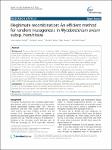Illegitimate recombination: An efficient method for random mutagenesis in Mycobacterium avium subsp. hominissuis
Khattak, Faisal A.
Kumar, Ashutosh
Kamal, Elisabeth
Kunisch, Ralph
Lewin, Astrid
Background: The genus Mycobacterium (M.) comprises highly pathogenic bacteria such as M. tuberculosis as well as environmental opportunistic bacteria called non-tuberculous mycobacteria (NTM). While the incidence of tuberculosis is declining in the developed world, infection rates by NTM are increasing. NTM are ubiquitous and have been isolated from soil, natural water sources, tap water, biofilms, aerosols, dust and sawdust. Lung infections as well as lymphadenitis are most often caused by M. avium subsp. hominissuis (MAH), which is considered to be among the clinically most important NTM. Only few virulence genes from M. avium have been defined among other things due to difficulties in generating M. avium mutants. More efforts in developing new methods for mutagenesis of M. avium and identification of virulence-associated genes are therefore needed. Results: We developed a random mutagenesis method based on illegitimate recombination and integration of a Hygromycin-resistance marker. Screening for mutations possibly affecting virulence was performed by monitoring of pH resistance, colony morphology, cytokine induction in infected macrophages and intracellular persistence. Out of 50 randomly chosen Hygromycin-resistant colonies, four revealed to be affected in virulence-related traits. The mutated genes were MAV_4334 (nitroreductase family protein), MAV_5106 (phosphoenolpyruvate carboxykinase), MAV_1778 (GTP-binding protein LepA) and MAV_3128 (lysyl-tRNA synthetase LysS). Conclusions: We established a random mutagenesis method for MAH that can be easily carried out and combined it with a set of phenotypic screening methods for the identification of virulence-associated mutants. By this method, four new MAH genes were identified that may be involved in virulence.
No license information

